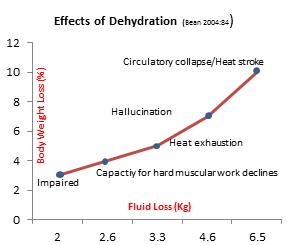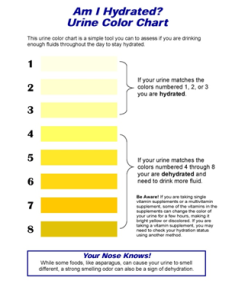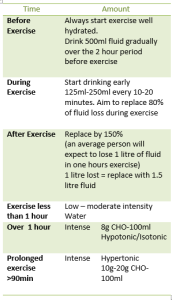Dehydration results from inadequate intake of fluids. It is a cumulative effect, in other words the symptoms are mild in the beginning and can become more serious over a short period of time. Avoiding dehydration is therefore imperative as this will lead to a gradual reduction in physical and mental performance.
So what happens in our bodies if we don’t drink enough?

Remember the thirst sensation is not automatic and when you start to feel thirsty you are possibly already dehydrated!
How do I become dehydrated?
Drinking insufficient fluids outside exercise is a common cause of dehydration and the average individual drinks a lot less than the following recommended levels.
| RDA Fluids (EFSA 2010) (outside sport) | ||
| 20% comes from food | -20% | |
| Females >14yr | 2lt | 1.6lt |
| Males >14yr | 2.5lt | 2lt |
Starting your exercise dehydrated is not a good idea and will lead to problems during your running.
How do I know if I’m dehydrated?
Well it’s as simple as this…
….take the time to study your pee as this is the best indicator of hydration levels in the body…use the following pee chart to determine your hydration levels.
So how do I become dehydrated during exercise?
Simply put we sweat. Sweat glands in your skin make sweat, also known as perspiration, and is made almost completely of water, with tiny amounts of other chemicals like ammonia, urea and electrolytes.
Sweating is the bodies response to maintaining a safe body temperature(36-38°C). It is effectively the removal of heat from the body. Most elite athletes are interestinely able to maintain higher core temperatures during exercise however for the rest of us it is extremely dangerous if our cooling systems are not working properly!
The amount of sweat that you produce is individual and depends on: Exercise duration and intensity, fitness level, environment- temperature and humidity, body size.
What else is lost in sweat?
Electrolytes are also lost when we sweat, these are electrically-charged particles, and maintain electrical charges across cell membranes and carry electrical impulses (nerve impulses, muscle contractions, etc.) across themselves and to other cells.
Your kidneys keep the electrolyte concentrations in your blood constant despite changes in your body.
For example, when you exercise heavily, you sweat a lot and lose electrolytes in your sweat. These electrolytes must be replaced to keep the electrolyte concentrations of your body fluids constant, to maintain the proper balance of water on either side of the cell membranes and maintain electrical charges and impulses.
Replacement of electrolytes lost in sweat can normally wait until the recovery period (Jenkendrup & Gleeson, 2010) and can be added to your recovery snack/drink, however adding a pince of salt to your sports drink will encourage you to drink more!
How can I measure my sweat losses?
An effective and simple way to look at fluid loss is to monitor body weight changes before and after exercise.
Start with the measure of body mass prior to exercise. Ideally this should be done nude, but usually it is appropriate to do the measure in minimal clothing. Any volume of drinks taken during exercise will also need to be measured. You can easily do this by weighing water bottles at the start and end of exercise. During exercise, if at any time you need the toilet, their weight must be taken before and after. After exercise, body weight should be taken in the same clothing as before exercise, and any excess sweat on the skin should be towelled off
Equation
sweat loss = (body weight before – body weight after) + amount of fluid intake – toilet loss.
So how much should I drink during exercise?
The chart below is only general recommendations set out by ACSM (american Collage of Sports Medicine). To be more accurate on your needs measure your sweat losses!!
Is it possible to drink too much?
Yes absolutely!! Hyponatremia is a condition that occurs when the level of sodium in your blood is abnormally low.
Drinking too much water during endurance sports — causes the sodium in your body to become diluted. When this happens, your body’s water levels rise, and your cells begin to swell. This swelling can cause many health problems, from mild to severe.
Symptoms: Headache, confusion, fatigue, muscle weakness, spasms, cramps, loss of consciousness, seizures, coma.
When it occurs in triathletes, it usually happens during long or ultra-distance races in the heat but may occur anytime.
It is estimated that approximately 30% of the finishers of the Hawaii Ironman are both hyponatremic and dehydrated. The longer the race, the greater the risk of hyponatremia .
Confused about salt/Sodium?
Salt is sodium plus chloride. Both are minerals. Salt is made up of 40% sodium and 60% chloride. The RDA for salt in Ireland for adults is 4g of salt or 1.6g of sodium the equivelant to ¾ of a teaspoon. Remember if sweating is excessive sodium needs to be replaced above the RDA. Adding a little salt will increase the desire to drink, promotes both carbohydrate and water uptake by the intestines and decreases urine output.
Final Note
As a novice middle distance and aspiring long distance runner I understand the difficulties of comsuming large amounts of water during road runs and trying to achieve the recommended intakes is very difficult.
Not to mention the uncomfortableness of running with a belly full of fluids sloshing around, there are also many practical issues with drinkinig during exercise namely; carrying the bottles, toilet breaks and cramping. If we consider that we should drink 1lt over 2 hours even the weight of this is exhausting! Therefore as I am learning every day it is very important to plan ahead for the long runs, start the run well hydrated, plan your route and leave bottles on the way, take some cash with you to buy drinks and figure out the toilet situation for your route!! Happy running!





Hi Lisa, super article, thank you. Do you know much about the benefits of Coconut Water?
Thanks Lisa, I love Coconut water so i’m thrilled X